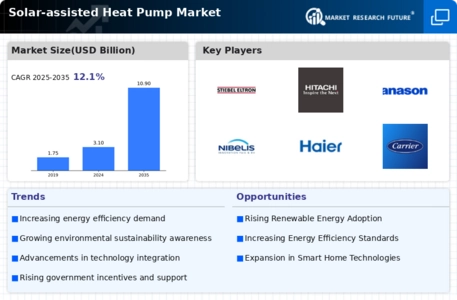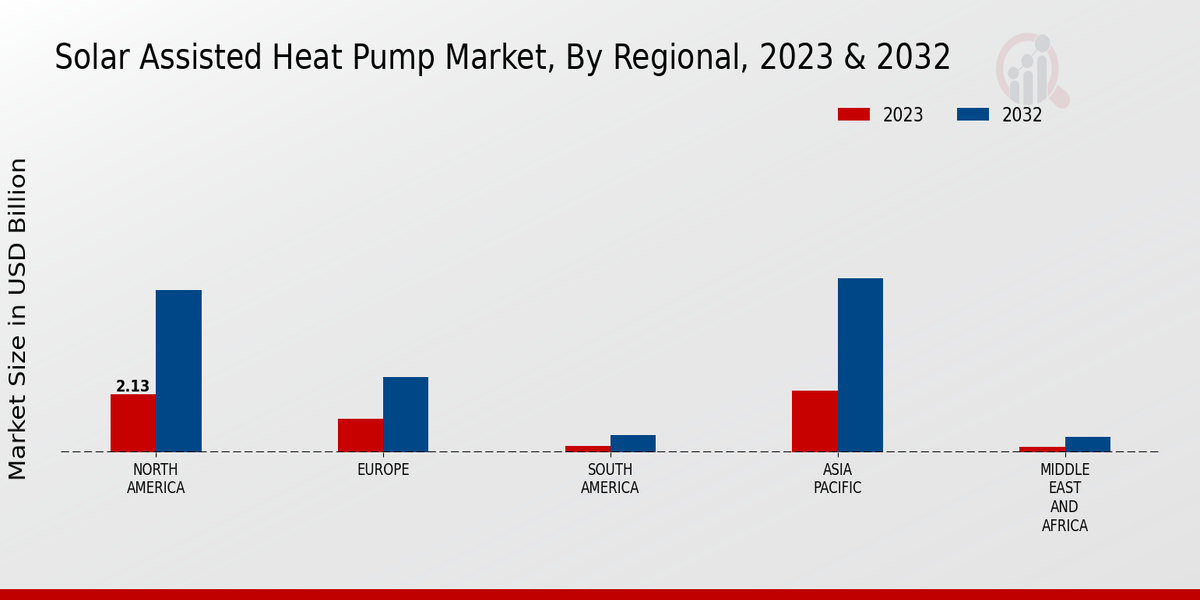Technological Advancements
Technological innovations are significantly influencing the Global Solar-assisted Heat Pump Market Industry. Advances in solar panel efficiency, heat pump design, and integration technologies have enhanced the performance and reliability of these systems. For example, the development of hybrid systems that combine solar-assisted heat pumps with traditional heating methods allows for greater flexibility and efficiency. As these technologies evolve, they are expected to lower installation and operational costs, making solar-assisted heat pumps more accessible to a broader audience. This trend may contribute to a compound annual growth rate of 12.07% from 2025 to 2035.
Growing Environmental Awareness
Increasing environmental consciousness among consumers is driving the Global Solar-assisted Heat Pump Market Industry. As awareness of climate change and environmental degradation rises, individuals and businesses are more inclined to adopt sustainable practices. Solar-assisted heat pumps, which utilize renewable energy sources, align with these values by reducing reliance on fossil fuels and lowering greenhouse gas emissions. This shift in consumer behavior is likely to spur demand for solar-assisted heat pumps, as more people seek eco-friendly alternatives for heating and cooling. The market's growth trajectory appears promising as sustainability becomes a priority for many.
Government Incentives and Policies
Government initiatives play a crucial role in shaping the Global Solar-assisted Heat Pump Market Industry. Many countries are introducing policies that promote the use of renewable energy technologies, including solar-assisted heat pumps. These policies often include financial incentives such as tax credits, rebates, and grants, which encourage consumers to invest in these systems. For instance, various nations have set ambitious targets for reducing carbon emissions, which aligns with the benefits of solar-assisted heat pumps. As these incentives become more widespread, the market is likely to see accelerated growth, contributing to a projected market size of 10.9 USD Billion by 2035.
Rising Demand for Energy Efficiency
The Global Solar-assisted Heat Pump Market Industry is experiencing a notable increase in demand for energy-efficient solutions. As energy costs continue to rise, consumers and businesses are seeking alternatives that reduce energy consumption while maintaining comfort. Solar-assisted heat pumps, which utilize renewable solar energy, present a viable solution. In 2024, the market is projected to reach 3.1 USD Billion, reflecting a growing awareness of energy efficiency. This trend is expected to continue as governments implement stricter energy regulations and incentives, further driving the adoption of solar-assisted heat pumps.
Urbanization and Infrastructure Development
Urbanization and ongoing infrastructure development are pivotal factors influencing the Global Solar-assisted Heat Pump Market Industry. As urban areas expand, the demand for efficient heating and cooling solutions increases. Solar-assisted heat pumps offer a sustainable option for new residential and commercial buildings, aligning with modern construction practices that prioritize energy efficiency. Additionally, many urban centers are implementing smart city initiatives that integrate renewable energy technologies. This trend is expected to bolster the market, as urban planners and developers recognize the long-term benefits of incorporating solar-assisted heat pumps into their projects.
























Leave a Comment